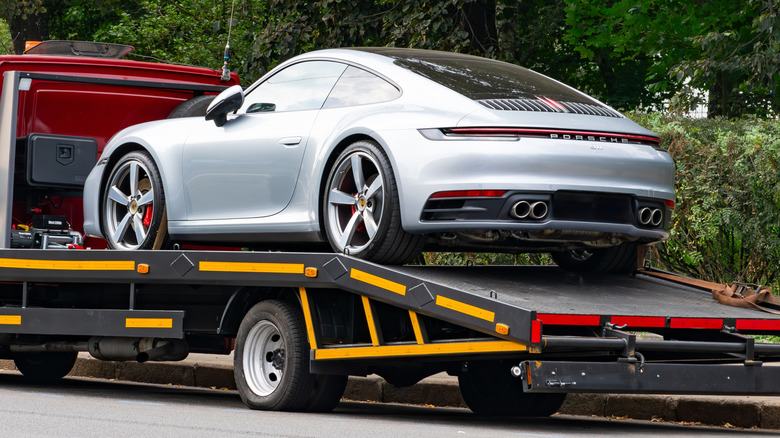What Happens If You Tow A Car In Park?
Whether it's due to bad parking, a car breakdown, or even an accident, knowing how to safely tow a vehicle can be the difference between a minor inconvenience and thousands of dollars in damage. However, towing a car while its gear lever is placed in Park leads to the latter — but is that always the case? The answer depends on how the car is towed and whether it's an FWD, RWD, or AWD vehicle.
For a FWD car, you can safely tow it with the front wheels off the ground. For an RWD car, the rear wheels need to be off the ground. Depending on the towing method, you can also use dollies to lift the drive wheels on both FWD and RWD cars. For an AWD car, it's a bit more complicated. AWD cars require either a flatbed or dollies on all four wheels. Whatever you do, do not flat tow a car –all four wheels on the ground — in Park.
The damage that occurs when towing a car in Park usually comes from the parking pawl being stressed, which leads to a huge repair bill. The idea here is not to drag the wheels that drive the car, since that forces the transmission to endure movement it wasn't designed to handle. In best-case scenarios, your wheels are going to skid in place. The worst: catastrophic damage to the transmission and drivetrain.
Towing a car in park the correct way
When a car is placed in park, it engages the parking pawl that stops the drive wheels from rolling. If you tow it without raising the drive wheels, it is going to strain the pawl. If the pawl breaks loose, it could potentially send metal fragments into the transmission, and that can be the end of it.
With that in mind, if you can't raise your drive wheels off the ground or use dollies, you can invest in axle locks or lube pumps to minimize any potential damage. While on dollies, it's imperative to tow slowly to minimize any strain. Moreover, only use a flatbed if you aim to tow for longer distances. It's also a good idea to use a spotter while loading a vehicle onto dollies to ensure proper alignment and that all the wheels are facing the correct direction.
Professionals often rely on flatbed solutions since these are the least likely to damage a car's transmission. Whatever you decide to do, always make sure your parking brake is disengaged and that you balance all of the wheels onto the dollies properly. If you can, try to override shift locks if your car allows you to do so manually. Lastly, although FWD and RWD can be towed in neutral on dollies, AWD cars should never be towed in neutral.
Knowing when to call a professional is crucial
If you don't have the tools for the job or lack the experience, knowing when to call a professional is the best way to avoid dangerous towing mistakes. Relying on skates, dollies, manual shift overrides, and steering wheel techniques can work wonders and minimize any chances of damaging your or anyone else's car.
The specific know-how of a professional can make all the difference when it comes to safe towing. For example, according to Ford's (link downloads a PDF to your devices) Wrecker Towing Manual: "When a vehicle is being towed with the front wheels on the ground, the steering wheel should be locked into place using an approved locking device." These are the little things amateurs are more likely to ignore, but can play a massive role in the final result.
Electric vehicles and hybrids rely on systems such as regenerative braking, high-voltage batteries, and electronic drive units, all of which are delicate and require proper handling. A professional should be trained to navigate these challenges. However, always make sure to ask them about their experiences towing hybrids and EVs beforehand, and about insurance policies if anything were to go wrong.


